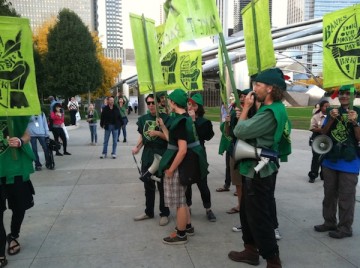After 22 years of Richard M. Daley, the longest-serving mayor in Chicago’s history, our city has a new mayor, Rahm Emanuel. While artists often greet new politicians with a screed of demands, The Happiness Project, which opens in various spaces in Chicago in November, invites artists to illustrate what happiness might look like for themselves, others, and the city. What might a city that advances the collective goal of happiness look like? How might it function? What kind of conditions and policies would that city create?
After spending some time at Occupy Chicago this week and Occupy LA a few weeks ago, it is clear that many people across the United States are not happy. On October 11 in Chicago, during the Futures Industry Association’s and Mortgage Bankers Association’s annual meetings, a group of activists known as the Robin Hoods greeted the bankers as they entered Renzo Piano’s bridge to the Art Institute of Chicago. As the bankers walked high above the crowd to attend their party, the crowds of people below chanted, “We are the 99%.”
[youtube:https://www.youtube.com/watch?v=ZCEQInMymyU#!]
From February to June the Museum of Contemporary Art, Chicago (MCA) presented artist Susan Philipsz’s sound works We Shall Be All and Internationale, reflecting Chicago’s rich labor history which includes the 1886 Haymarket Affair and the creation of the International Workers of the World (IWW). Also in Chicago in March, artist Paul Durica organized a reenactment of the 1915 Parade of the Unemployed, which at the time demanded hunger relief and public works projects. Both artists draw parallels to the similarities between then and now. So, what is to be done?
Recently addressing Occupy Wall Street, critical theorist Slavoj Zizek said, “We don’t want higher standards of living; we want better standards of living.” The current paradigm for measuring standard of living is the GNP (gross national product) index. However, because consumption of products doesn’t necessarily correspond to one’s standard of living–as evidenced when traffic jams increase gasoline consumption–the country of Bhutan has proposed the GNH (gross national happiness) index as the new “standard of living.” When the Dalai Lama visited Chicago in June, he urged people to pursue happiness. The next day, the United Nations’ General Assembly encouraged its Member States to give importance to happiness and well-being in measuring and achieving social and economic development.
During a time of economic, political, and social uncertainty it might be considered a luxury to make decisions based on happiness. But I would advocate that it is a power, and according to the American constitution, the pursuit of happiness is a right. While happiness is often considered subjective, there is a consensus that happiness and quality of life depends on some key factors. The GNH index proposes nine indicators of happiness: physical and psychological well-being, ecology, health, education, culture, living standards, time use and balance, community vitality and good governance. At the most fundamental level, happiness and well-being depends first on a sense of psychological well-being, then on the quality of our relationships and environment. A connection to others is key; from family and friends, to a larger sense of community. Environmental and cultural vitality are also necessary conditions. In addition, a sense of political connection (or voice) clearly shows the interrelationship between all of the indicators. When people feel that they are being heard, they feel empowered; when people feel they are not, such as those in Egypt and in cities across America, they take to the streets as a collective voice demanding to be heard.
The Happiness Project was conceived as a way to give artists a voice as Chicago’s new Mayor was creating his new cultural policy. But given the recent events of people coming together to demonstrate and make their voices heard, the project also reflects and builds upon the growing desire for public participation and communal connections and conversations through a range of actions, interventions, and events. The Happiness Project includes performances and dinners for Chicagoans to discuss the creative future of the city. Unlike work and more like play, the outcome of these directed, yet open, events are undefined. Presented within Chicago’s central business hub and in various neighborhoods to foster connections between “the city that works” and “the city of neighborhoods,” as well as ideas of work and play, The Happiness Project aims to re-purpose and re-imagine urban space. It transforms Chicago’s empty storefronts and spaces resulting from the economic downturn into new zones of activity where unexpected, transcendent possibilities are explored–as if in response to Zizek’s question, “We know what we do not want. But what do we want?”






Pingback: What Is To Be Done?* Conversations, Commerce, and Collaborations | Art21 Blog